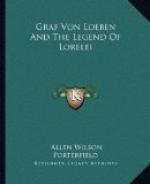[46] In Dichtungen von Heinrich Heine, ausgewAehlt
und
erlAeutert, Bonn, 1887,
p. 326. Hessel’s Statement is
peculiarly unsatisfactory,
since he says (p. 309) that he is going
to the sources of Heine’s
poems, and then, after reprinting
Loeben’s ballad, he
says: “Dieses Lied war Heines nAechstes
Vorbild. AusfUehrlicheres
bei Strodtmann, Bd. I, S. 362.” And
this
edition has been well received.
[47] In Grundriss, VI, 110. Again we read
in parentheses: “Aus
diesem Liede und dem EingAenge
der ErzAehlung schOepfte H. Heine sein
Lied von der Loreley.”
[48] In Ges. d. deut. Lit., p. 662 (8th ed.).
[49] In Heinrich Heines Beziehungen zum deutschen
Mittelalter,
Berlin, 1908, pp., 94-95.
MUecke is the most cautious of the ten
authorities above listed;
and he anticipated Walzel in his
reference to Schreiber’s
Handbuch.
[50] In Ueber den Namen Lorelei, p. 224. Hertz
is about as cautious
as Strodtmann; “Es ist
kaum zu bezweifeln dass,” etc.
[51] In SAemtliche Werke, I, 491.
[52] In HauptstrOemungen. VI, 178.
Brandes says: “Der Gegenstand
ist der gleiche, das Versmass
ist dasselbe, ja die Reimen sind an
einzelnen Stellen die gleichen:
blitzetsitzet; statt ‘an-gethan’
steht da nur ‘Kahn-gethan.’”
[53] In Der deutschen Romantiker, Leipzig, 1903, p. 235.
[54] In Deutsches Literatur-Lexikon, MUenchen,
1914, p. 271. It
is significant that KrUeger
makes this statement, for the subtitle
of his book Is “Biographisches
und bibliographisches Handbuch mit
MotivUebersichten und Quellennachweisen.”
And it is, on the whole,
an extremely useful book.
[55] It is impossible to see how Brandes can lay great
stress on the
fact that this rhyme occurs
in both poems. The following rhymes
are found on the following
pages of the Elster edition, Vol. I, of
Heine’s works:
“Spitze-Blitze” (36), “sitzen-nUetzen”
(116),
“Witzen-nUetzen”
(124), “sitzen-blitzen” (216),
“erhitzet-bespitzet”
(242), “Blitz-Sitz” (257), “blitzt-gestUetzt”
(276), “blitze-besitze”
(319), “blitzet-gespitzet” (464).
And in
Loeben’s poems the rhyme
is equally common. The first strophe of
his Ferdusi runs as
follows:
Hell erglAenzt
an Persiens Throne
Wo der grosse
Mahmud sitzt;
Welch Juwel
ist’s, das die Krone
So vor allen
schOen umblitzt.
And in Schreiber’s saga
we have in juxtaposition, the
words. “Blitze”
and “Spitze.” The rhyme “Sitze-Blitze”
occurs in
Immanuel’s “Lorelei,”
quoted by Seeliger, p. 31.
[56] There are, to be sure, only 114 words in Loeben’s
ballad if we
count “um’s,”
“dir’s,” and “glaub’s”
as three words and not six.




